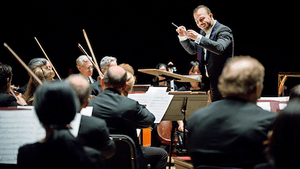Stay in the Loop
BSR publishes on a weekly schedule, with an email newsletter every Wednesday and Thursday morning. There’s no paywall, and subscribing is always free.
Unfinished but complete
The Philadelphia Orchestra performs 'Mozart's Great Mass'

Both Franz Schubert and Wolfgang Amadeus Mozart are known for unfinished masterpieces. In Schubert’s case, it’s his Eighth Symphony, better known simply as “The Unfinished,” and in Mozart’s, it’s the Mass in D Minor, the work he left incomplete on his deathbed. But another great Mozart choral work also exists in an unfinished state: his earlier Mass in C Minor. Yannick Nézet-Séguin conducted this latter work alongside Schubert’s Eighth in the Philadelphia Orchestra’s second subscription concert.
Is Schubert’s Eighth really unfinished?
Schubert wrote the piece’s two movements in 1822 and sent the score to friends, which suggests that he regarded it as a complete work. On the other hand, he sketched the beginnings of a third movement, which suggests an intention to extend it. Why he didn’t pursue this project remains a mystery, although it is inconceivable to me that Schubert didn’t recognize the revolutionary breakthrough the Eighth represented, not only among his own compositions but for music in general. A two-movement symphony would have been an anomaly in his time, and no deliberate example of another such work would emerge until Prokofiev’s Second Symphony, composed 100 years later.
The Prokofiev offers a tantalizing clue of its own, since it was deliberately modeled on Beethoven’s Piano Sonata, Op. 111, also a two-movement work. When Beethoven showed the score to friends, they objected that a sonata required at least three movements; he replied that only a fool could not see that the work was complete. Beethoven began the Sonata in 1821 and finished it in 1822. Could Schubert have seen or been aware of this work, and might it have given him second thoughts about “finishing” his own Eighth? It will probably never be possible to settle the question.
What we can say, though, is that the Eighth is in fact a triumphantly satisfying symphonic experience, and requires not a note to “complete” it. Posterity has made that decision — the Eighth was unperformed until 1865 — whether Schubert himself did or not. It is astonishing, the first Romantic symphony. Beethoven’s Pastoral Symphony, with its vivid tone painting, is clearly a forerunner, and Beethoven certainly realized the heroic aspect of Romanticism in his great odd-numbered symphonies.
Translating sennsucht into notes
The crucial element Schubert added, however, was sennsucht, the untranslatable German term that approximates feeling, longing, or yearning. Schubert, at 25, was already a veteran symphonist, but his previous works gave no indication of the new world of expression he was about to open. His Ninth and last symphony would be another matter, a grand farewell to the Classical symphony, full of feeling to be sure, but not with sennsucht. Because the Eighth lay unperformed for decades, Berlioz’s Symphonie Fantastique (with which the orchestra opened its season) has generally been given honors as the first Romantic symphony, and no one would dispute its originality. But pride of place rightfully belongs to Schubert. Nézet-Séguin began his performance with clipped phrasing, suggesting an intention to emphasize the score’s residual classical elements, but he gave full rein to the work’s expressiveness. The orchestra responded with sensitivity and deep beauty of phrasing.
Mozart was creating fully mature masterworks by his mid-teens, but his development did proceed in sudden spurts of growth. The works of the K. 420s marked such a point, including as they do, the String Quartets K. 421 and 428 and the Linz Symphony K. 425, as well as the C Minor Mass. The work is not the torso that the D Minor Mass was, but parts of its movements were never fully finished, and it “lacks” an Agnus Dei. Nonetheless, it is (with the glorious Sanctus and Benedictus that concludes it) as complete, and completely satisfying a work as the Schubert.
Unlike the Schubert Eighth, the C Minor Mass did have important Baroque precedents, notably Bach’s B Minor Mass. But it has its very own devotional character, mixed too with strikingly operatic elements, and you should not leave this planet without hearing it in concert. The heaviest vocal load fell on mezzo-soprano Kate Lindsey, who brought off dazzling vocal leaps, particularly in the Laudamus te, while soprano Lucy Crowe had her own innings in the wonderful Et Incarnatus est. Under Joe Miller, the Westminster Symphonic Choir was, as usual, in splendid form, carrying the score’s most thrilling passages above the orchestra’s fine accompaniment. Nézet-Séguin plainly loves this music, and it showed.
The concert began with "Rainbow Body," a 14-minute work by Yale-based Christopher Theofanidis. The title refers to the Tibetan Buddhist concept of the physical body returning to the universe after death as energy or light, and its central motif is based on Hildegard of Bingen’s “Ave Maria, O auctrix vita” (“Hail Mary, O source of life”). As is often the case with contemporary composition, there’s a great deal of learned reference behind music of middling character. Theofanidis knows how to use an orchestra, and the music is interesting, in parts suggesting a tone poem. The orchestra made the best case for it, and for music that was gratifying, rather than grating, to the ear.
What, When, Where
Mozart's Great Mass. The Philadelphia Orchestra, conducted by Yannick Nézet-Séguin, with the Westminster Choir, Joe Miller directed. Through Oct. 2, 2016 at the Kimmel Center, Broad and Spruce Sts., Philadelphia. (215) 893-1999 or philorch.org.
Sign up for our newsletter
All of the week's new articles, all in one place. Sign up for the free weekly BSR newsletters, and don't miss a conversation.

 Robert Zaller
Robert Zaller